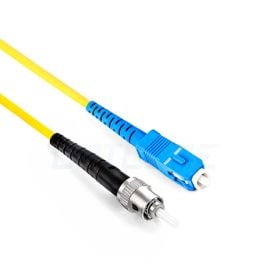Blog, Network Cabling, Networking Device
Loopback Test: What It Is and How to Do It
A loopback test is a diagnostic procedure. In the process, signals are transmitted from various devices (e.g., cables, network adapters, switches, and routers) and then come back to them. The test is mainly for verifying whether signal transmissions are integral or correct.
As a crucial tool for checking network and device problems, the loopback test avoids unnecessary connections. It also helps business owners and IT specialists determine whether their devices are functioning properly. This blog begins by explaining what a loopback test is, then introduces its main types, use cases, and advantages, and finally teaches you how to do this test.
Table of contents
Loopback Test Definition
While using cables, routers, switches, and other network equipment, have you ever had any issues and been puzzled about how to tackle them? In this case, you likely need to perform a loopback test to find where your problems lie.
The loopback test is a useful method that has a wide application in such fields as computer networks, telecommunications, and network devices. With this tool, you can ensure that communication links and network equipment function well. To do the loopback test successfully, you first need a loopback adapter or a loopback cable. By creating a closed loop, this type of test allows technicians to confirm the hardware and software interfaces of network devices to ensure their proper functioning.
Fanless Design: Like some Cisco 1300 switch models, most Cisco 1300 switch models are fanless. This design reduces power consumption, enhances reliability, and allows quieter operation. Such a feature perfectly fits non-noisy settings, such as classrooms and libraries.
Further Reading
Loopback Test Types
In general, a loopback test comes in four types. Their classifications are based on different usage and whether the test is conducted internally or remotely.
Local Loopback Test: A single device or system can make use of such type of test. The reason is that signals existing in devices and systems are routed internally; they transmit within the devices. This test aims to verify the hardware and software interfaces of network devices, ensuring they are in a proper state.
Remote Loopback Test: In this test, external communication links transmit huge amounts of data and make it come back to remote systems and devices. Its main function is to check if the entire communication path (immediate devices and pathways included) is integral and reliable. For this reason, a remote loopback test is vital to diagnosing related issues within communication systems.
Digital Loopback Test: This test is operated at the digital level. It mainly transmits digital data via communication channels and then returns the data digitally. With the help of this test, technicians are able to find the reliability of data transmission and reception.
Analog Loopback Test: Compared to the digital loopback test, this test is suitable for detecting issues in analog communication systems. The working principle is as follows: the system first sends analog signals, and then it loops them back to confirm the reliability of the analog signal path.
Use Cases for Loopback Tests
Network Devices
In modern society, network devices, including switches, routers, and network interface cards, have become widely applicable. If they do not run properly, consider performing a loopback test to determine if adjustments are needed. Through this test, you can have an immediate check for potential issues within your network devices. This ensures the devices are in good condition and guarantees network stability.
Telecommunications Sector
In the telecommunications sector, the loopback test helps discover the issues hidden in telephone lines, modems, and related communication devices. Additionally, this type of test enables workers in the communications industry to rule out specific faults or errors in the communication path. In this way, the reliability of data transmission is possible.
Computer Networks
A loopback test brings many benefits to the function verification of serial and parallel ports, as well as other peripheral interfaces. Using this test, system administrators are easy to locate network issues and ensure computer hardware runs correctly.
Embedded Systems
Embedded systems consist of various communication interfaces, including SPI and I2C. The loopback test is essential for these systems to check the health of communication interfaces. When these interfaces function well, embedded devices will have a reliable performance.
Benefits of Loopback Tests
Versatility: From a glimpse of loopback test types and uses, it is clear that this useful test has numerous applications. It applies to digital data transmission and analog communication systems. Besides, the loopback test covers the fields of telecommunications and computer networks.
Diagnostic Accuracy: For IT managers and business owners, a quick and easy way of network troubleshooting is to use a loopback test. This is because this test has the capability to offer precise diagnostic results. Based on these results, technicians can mark the accurate location of a systemic fault quickly. With issues being found, the test can reduce the time and effort required for further troubleshooting.
Enhanced Reliability: This is due to having done regular loopback testing of your communication systems. Since a loopback test helps identify issues with a specific system early, it means your system will improve its operational performance. Moreover, a timely warning of possible system failures also makes computer systems run in a reliable state.
Cost-effective Maintenance: When you do the loopback test, only a few requirements are for additional services. This means you can engage in daily diagnoses and device maintenance more conveniently.
Simplified Troubleshooting: The troubleshooting process can be simple using a loopback test. It offers a direct and precise evaluation of a system’s functionality. With a simplified process, technicians can enhance the efficiency of the system.
How to Do Loopback Tests
A loopback test is beneficial when users need to identify network and device issues promptly and conveniently. However, doing this test also has a lot of things to take notice of. Here’s a concrete step for your reference.
1. Obtain a single strand of fiber optic cable with the correct port type (e.g., SC, LC, and MPO) and mode (SMF or MMF). A simplex cable or a duplex patch cable is helpful. Besides, you need to separate both ends of the same cable.

To better help you with loopback testing, OPTCORE has an extensive portfolio of fiber optic cables for you to choose from. They fit the requirements for your transceiver during the testing.
Note: The duplex cable needs isolating into two parts to make the operation much easier.
Optcore Fiber Optic Cables
-
SC-ST 9/125 OS2 Singlemode LSZH Simplex Fiber Patch Cable
Price range: US$ 2.00 through US$ 6.00 (Excl. VAT) -
LC-LC APC 9/125 OS2 Singlemode LSZH Simplex Fiber Patch Cable
Price range: US$ 1.70 through US$ 6.20 (Excl. VAT) -
LC-LC 10G OM3 Multimode PVC (OFNR) Duplex Fiber Patch Cable
Price range: US$ 2.80 through US$ 30.30 (Excl. VAT) -
HP AJ839A Compatible 50m LC-LC Multimode OM3 Duplex Fiber Patch Cable
US$ 22.00 (Excl. VAT)
2. Install the transceiver or module you want to do testing into the selected switch. This step may ask you to use an optical attenuator when you want to perform the test at 40 kilometers or beyond.
3. Insert the loopback cable into the Tx and Rx ports of the transceiver. Some transceivers may have high transmitting signal power, so you should use proper optical attenuators to protect the receiver port from a lens burn.
4. Analyze the results. If your test is unsuccessful, remember to determine what went wrong. You can either find another transceiver for checking or verify if the loopback cable is wrong. If the problem remains, verify the test port configuration.
5. Monitor the results by checking the status indicators on the switch. You need to verify if the transceiver, port, and configuration are in good functions. When the light is on, it shows the proper functioning. If the light is unlit, you need to implement the necessary troubleshooting.
Issues with Loopback Tests and Solutions
To achieve a safe and precise loopback test, you should consider several issues that arise from the testing process and seek effective solutions.
Firstly, keeping the end faces of your cables clean is very important. The best choice is the use of cleaning tools soaked in ethanol. In doing so, you can save the trouble of establishing unstable docking platforms or causing damage to the opposing joints.
Secondly, proper attenuation matters a lot while using an optical attenuator. When you install your transceiver, for example, a 10G SFP transceiver, to fit the switch, proper attenuation can protect the receiver port to avoid a lens burn. If network hardware suffers damage, you need to consider connector problems. Make sure to insert and remove the MPO connector via housing holding instead of the cable.
Lastly, do not misuse cables or connectors. If this happens, connectors won’t be compatible, and connections will go wrong. You need to check your equipment by means of a routing calibration and testing schedule in this case.
Conclusion
In summary, a loopback test is quite essential to single out the issues regarding network devices, computer systems, telecommunications, and embedded systems. Meanwhile, as a diagnostic procedure, this test needs performing with loopback adapters. If you’re eager to identify the underlying problems easily and rapidly, we will be delighted to offer you a step-by-step guide for loopback testing.
Reference










